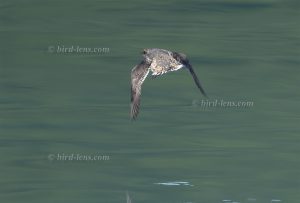 The big push for the last days of the birding tour in Alaska was to search for the Kittlitz’s Murrelet (Brachyramphus brevirostris). Kittlitz’s Murrelet is a rare member of the Alcid family of diving seabirds that includes the puffins, auklets and murres. This was one of the birds highest on my list, as it is a species that numbers in the low tens of thousands and does only rarely migrate along the west coast of the United States, and therefore can be seen mainly near its breeding grounds in Alaska. But in Alaska too, this bird is uncommon and local and there are recent evidences of decline.
The big push for the last days of the birding tour in Alaska was to search for the Kittlitz’s Murrelet (Brachyramphus brevirostris). Kittlitz’s Murrelet is a rare member of the Alcid family of diving seabirds that includes the puffins, auklets and murres. This was one of the birds highest on my list, as it is a species that numbers in the low tens of thousands and does only rarely migrate along the west coast of the United States, and therefore can be seen mainly near its breeding grounds in Alaska. But in Alaska too, this bird is uncommon and local and there are recent evidences of decline.
After a 2 week trip with the tour operator High Lonesome to the Pribilofs Islands, St. Lawrence and Nome to observe the impressive bird migration along the shore of the islands to the Bering Sea I wanted to complete birding in Alaska with some birds I missed or could not see further to the west.
During summer, populations of Kittlitz’s Murrelets are concentrated in areas with large glacial fields. For this I participated in a chartered boat trip with Saltwater Tours from Seward. From Seward Harbor we started in early June. We went on a veritable boat, which is approved for 20 people. We headed on Resurrection Bay south. When pulling out of harbor, we saw the first Double-crested Cormorants (Phalacrocorax auritus) and Pelagic Cormorants (Phalacrocorax pelagicus) sitting on rocks along the shore. Suddenfly Humpback Whales (Megaptera novaeangliae) raised their heads out of the water. Black-legged Kittiwakes (Rissa tridactyla) could be seen in large flocks. Shortly after we are able tp see the first auks in the water. They are Common Murres (Uria aalge), Pigeon Guillemots (Cepphus columba), Marbled Murrelets (Brachyramphus marmoratus), Parakeet Auklets (Cyclorrhynchus psittacula), Horned Puffins (Fratercula corniculata) and Tufted Puffins (Fratercula cirrhata). That’s an impressive list. It’s nice that the responsible persons of the operator of the boat – Saltwater Tours – try to match the specific expectations and wishes of the passengers. I had said in advance that I would like to see birds. The skipper tries to do its best. Thus the boat sails close-by past steep bird cliffs. Callisto Head jis such an overhanging cliff with breeding Red-faced Cormorants (Phalacrocorax urile) and Pelagic Cormorants.
The weather was very sunny and the swell was quite bearable. It took quite a long time (approximately 3 hours) until we finally circled around Aialik Cape. Now the entrance begins in the Aialik Fjord, where, at the end, Aialik Glacier is situated. Within manageable distance Aialik Glacier is the only accessible place for the highly-expected Kittlitz’s Murrelet. A small plump waterbird, with a short, pointed bill appears. The bird shows a partly specled, sooty brown on its upperparts. Obviously they are Marbled Murrelets, which dive quickly when approaching. A Rhinoceros Auklet (Cerorhinca monocerata) floats past the boat one time. It becomes noticeably colder. The slices of ice of the glacier swims on top of the water and cools the air substantially. We drive for a while towards the fjord. Finally, we are approaching an ice barrier. Here you have to drive really carefully. The Murretlets unfortunately – unlike announced – do not become more. Unfortunately, rather less. Most Murrelet yet seem to be Marbled Murrelets. After all, I was successful to recognize a Kittlitz’s Murrelet. Alaska government has an excellent leaflet for field identification of Kittlitz’s Murrelet where they say, that plumage color can be an excellent guide to distinguish Marbled Murrelets and Kittlitz’s Murrelet. On close distance the back of the Kittlitz’s Murrelet is mottled gray with flecking of tan or gold. At sea, under varying light conditions, Kittlitz’s Murrelet can appear gray, silver, or a warm tan color. In contrast, the Marbled Murrelet is mottled brown on the back, with flecks of foxy-brown or almost rufous-brown color. In fact the pictures I shot show very the well a frosty grey color whereas the Marbled Murrelet will never appear gray or silver, always brown.  Additionally the white belly and the coverts and eventually after departure you could identify the white outer tail feathers.
Additionally the white belly and the coverts and eventually after departure you could identify the white outer tail feathers.
In order to satisfy the growing demand for top shots of the rarer species of Western Palearctic, Bird-lens.com has undertaken dedicated trips to nearby and distant bird areas. This is to be able to do anything to provide excellent images of the birds of the Western Palearctic. Sometimes the yield of images is enriched by bird species, which are very unlikely to show-up in the Western Palearctic. The results in images even of rare Western Palearctic birds are very good.
The beautiful images of the blog are only a first impression of what you will find in behind the rider “Picture- Shop” very soon. Simply contact bird-lens.com if you need the image of a bird before the newest images are online.